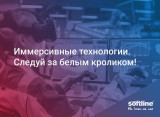Иммерсивные технологии. Технологии, которые позволяют создать для пользователя виртуальный мир либо сделать микс из виртуального мира и реальности.
Добро пожаловать в Страну чудес!
Самое время вспомнить Алису из книги Льюиса Кэрролла. Сейчас оказаться в Стране чудес очень просто. Хотите полное погружение? Вас выручит VR или виртуальная реальность. Это полностью смоделированный при помощи современных технологий иллюзорный мир, в который входят не только 3D-графика или сцены 360, но также звук, тактильные ощущения и даже запахи. Достичь такого эффекта позволяет использование специализированных устройств (например, шлемов виртуальной реальности). На следующем этапе развития технологии ожидается появление возможности полного погружения в виртуальный мир до уровня, когда уже не получится отличить визуализацию от реальности.
Следует отметить, что оборудование для VR становится все более и более доступным обычным пользователям. Например, стоимость VR-шлемов Oculus в настоящее время начинается от $500, что при желании можно себе позволить.
Следуйте за белым кроликом!
Не хотите оказаться полностью в Стране чудес, но зато мечтаете увидеть белого кролика, который посмотрит на часы, запричитает и нырнет в ближайший канализационный люк за неимением норы? Да пожалуйста. Здесь вам в помощь AR или дополненная реальность. С ней мы продолжаем видеть окружающую обстановку, но с помощью специального оборудования, например очков, добавляем в нее несуществующие, виртуальные элементы. Для дополненной реальности, кроме очков, используются еще heads-up display (индикаторы на лобовом стекле автомобиля), специальные шлемы (HMD) и даже просто смартфоны.
Очки дополненной реальности пока не относятся к распространенным гаджетам, но в 2021 или 2022 году ожидается появление Apple Glass, которые могут в корне изменить ситуацию. Эксперты предрекают успех этой разработке.
Развлечения? Не только!
Безусловно, у иммерсивных технологий большое будущее в сфере развлечений, но еще большее – в образовании и медицине. С отрывом от них идут архитектура, проектирование, строительство, дизайн и ритейл. Но это все лишь на текущий момент. Ситуация меняется, виртуальная реальность все больше и больше входит в нашу жизнь, а возможности ее воистину безграничны.
Иммерсивные технологии в обучении
Согласно государственной дорожной карте развития технологий виртуальной и дополненной реальности: «Внедрение VR/AR в образовательном сегменте позволит обеспечить доступные инструменты для пользователей и дополнить обучающие программы интерактивным визуальным VR/AR-контентом в размере до 30% всех образовательных материалов. При развитии маркетплейса образовательных проектов возможно получение российскими компаниями 15% мирового рынка VR-образования».
Уже сейчас для обучения медицинского персонала во многих городах успешно действуют симуляционные центры, в которых в виртуальной реальности отрабатываются навыки в сфере хирургии, реаниматологии и интенсивной терапии, акушерства и гинекологии, сестринского дела, ухода за больными и многого другого. Кроме Москвы и Санкт-Петербурга такие центры есть в Курске, Рязани, Красноярске, Кирове, Омске, Томске и других городах.
Тренажерные технологии с использованием VR необходимы там, где ошибки в ходе обучения на реальных объектах могут привести к ЧП и большим финансовым затратам. С помощью этих технологий учащиеся могут управлять виртуальной моделью любого технологического приспособления.
VR/AR в медицине
Виртуальная реальность постепенно внедряется и используется для реабилитации пациентов, перенесших различные заболевания. К примеру, в Пироговском центре VR-решения применяются для восстановления пациентов, перенесших черепно-мозговые и спинальные травмы, а также инсульты. К сожалению, медицинские разработки требуют обязательной регистрации и сертификации, что затрудняет их внедрение.
Одним из немногих VR-комплексов реабилитации, имеющим медицинскую регистрацию, является российский комплекс «Девирта-Делфи». В нем есть четыре модуля: восстановление движения крупных суставов и мелкой моторики, а также программы «антиболь» и эрготерапия (восстановление бытовых навыков).
Еще один разработчик подобных технологий, Медицинский центр ДВФУ, в настоящее время ведет клинические испытания комплекса для реабилитации пациентов после инсульта. Ожидается, что решение повысит эффективность восстановления больных более чем на 25% и на 30% снизит время функциональной реабилитации.
Перспективными направлениями VR-технологий в медицине являются также борьба с фобиями, страхами и другими психологическими недугами. AR-технологии также могут оказывать помощь в проведении операций, например, создавая для хирургов иллюзию рентгеновского зрения.
VR/AR в ритейле, строительстве и архитектуре
Пока не так развиты, как предыдущие два направления, однако и в этих сферах успехи впечатляют.
Инструменты VR/AR в ритейле направлены в первую очередь на обеспечение для клиента возможности «примерить» товар на себе или в своем интерьере. К примеру, приложение IKEA Place с помощью смартфона позволяет разместить предметы мебели в пространстве комнаты. Также иммерсивные технологии помогают ориентироваться в ассортименте, сокращают издержки и автоматизируют бизнес-процессы, а также мотивируют потребителей на покупки с помощью цифровой визуализации.
Виртуальное прототипирование в строительстве и архитектуре позволяет проверить эргономику зданий, проконтролировать их надежность, а также вести коллективное обсуждение проектов и демонстрировать их.
Перспективы
Мы находимся на начальной стадии внедрения VR/AR-технологий в повседневную жизнь, но темпы развития велики. Немалую роль в этом сыграла и эпидемия коронавируса. В ближайшие несколько лет ожидаются существенные подвижки в распространении технологий как в бытовой сфере, так и в области таких отраслей, как медицина, образование, торговля, строительство и другие.
